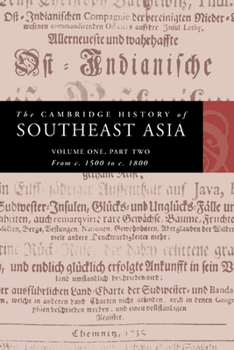The Cambridge History of Southeast Asia
(Part of the The Cambridge History of Southeast Asia Series)
Select Format
Select Condition 
Book Overview
In these four volumes, now published in paperback, twenty-two scholars of international reputation consider the whole of mainland and island Southeast Asia from Burma to Indonesia. Each volume has a... This description may be from another edition of this product.
Format:Paperback
Language:English
ISBN:0521663709
ISBN13:9780521663700
Release Date:January 2000
Publisher:Cambridge University Press
Length:320 Pages
Weight:1.36 lbs.
Dimensions:0.8" x 6.0" x 9.1"
Customer Reviews
1 rating
Excellent Introduction to the Early History of SE Asia
Published by Thriftbooks.com User , 20 years ago
Southeast Asia is often the forgotten sister of Asia in that when people study the region or mention it, they talk about China, Japan or India, and when Southeast Asia IS referred to, it is often in context with the Vietnam War and subsequent spinoff conflicts resulting from that war. This is unfortunate, as Southeast Asia has a rich history with a variety of interesting and highly successful cultures. In this first of four volumes, Southeast Asia from prehistoric times to about A.D. 1500 is discussed in depth in five chapters written by different scholars addressing their individual specialties in the region. This is what sets Cambridge Histories apart from most others. J.D. Legge's article addresses the very history of the writting of Southeast Asia. He discusses in depth the differences between Pre WWII and Post WWII scholarship. World War II is when the region caught the attention of scholars due to importants in the war, and consequently, SE Asia studies programs blossomed, both in Western countries as well as in the Pacific Asia region. Peter Bellwood talks about prehistoric Southeast Asia. The various environmental regions (especially of the island regions) is explored in depth. Also of import is the expansion of Austronesian (Malayo-Polynesian) languages from its hearth in Taiwan into Southeast Asia and its consequent spread both eastward into the Pacific as well as westward to Madagascar off the African coast. Keith Taylor discusses the early kingdoms of the region. Vietnam, Champa, Angkor (Cambodia), Pagan (Burma), Ayutthaya (Thailand), Srivajaya (mostly Southern Sumatra) and Majapahit (Java) are discussed in detail. Their evolution as Indianized states (with the exception of Vietnam) is discussed, and the conventional wisdom of the nature of that Indianization is challenged in convincing fashion. Kenneth Hall talks about the nature of the economies of the early Southeast Asian kingdoms. He makes the distinctions between rice-based economies and those based on trade. Especially successful was East Java due to its access both to rich agricultural areas and its geographic proximity to the Spice Islands over which much of the world trade focused on during that time in history. The case is made that this region of Southeast Asia dominated global trade in the centuries leading up to the 16th century. J.G. de Casparis and I.W. Mabbett discusses religion, and once again, the issue of Indianization pops up. The differentiation of mainland and island Southeast Asia is brought up, concluding with the beginnings of Islam in kingdoms like Aceh as we approach the 16th century. This is all highly academic, as one would expect from Cambridge. However, this also reflects the most recent scholarship on this very diverse and fascinating region of the world. Given the importance of this region today in terms of global trade and the war on terror, an understanding of this region has never been more important. This book has a lot to





